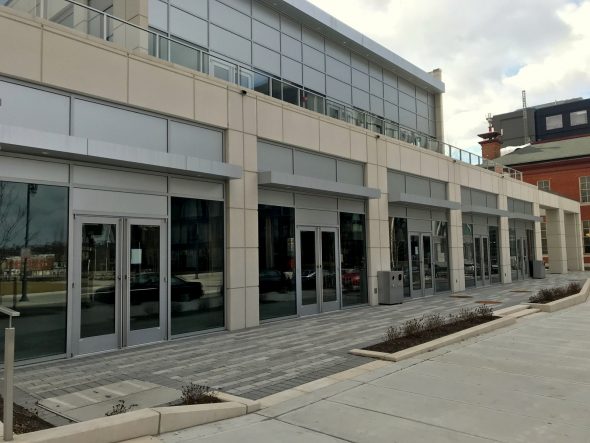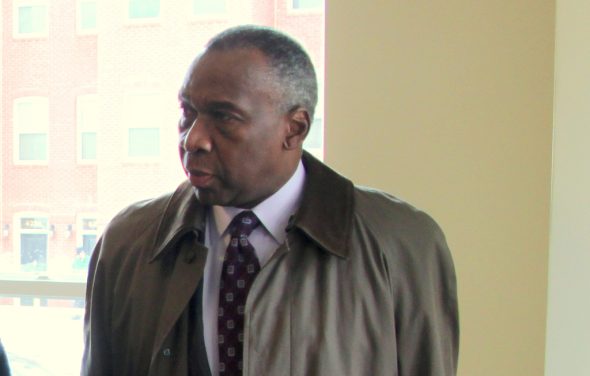
Above Photo: The 15-story Marriott at the Johns Hopkins Medical Center describes itself as an all-suite residence for long stays. (Mark Reutter)
No grants for Sandtown-Winchester, Penn North, Harlem Park, Forest Park and Mondawmin
Following a year of declarations by Mayor Catherine Pugh that historically underfunded black communities should receive more investment from the state, guess who’s getting the largest chunk of Baltimore Regional Neighborhoods Initiative (BRNI) money this year?
An upscale hotel.
With today’s approval of a resolution of support by the mayor and the Board of Estimates, the Maryland Department of Housing and Community Development will release another $800,000 of BRNI funds for the Marriott Residence Inn, a hotel that caters to patients and their families at the Johns Hopkins Medical Center.
This money will supplement the $1.4 million the project was already awarded under the same program.
The Baltimore Regional Neighborhoods Initiative was established by the legislature to provide strategic investments that lead to “healthy, sustainable communities” in Baltimore City and inner-Beltway communities.
Traditionally, the funds have been divided into small parcels ($50,000 to $150,000) for local greening projects, business facade improvements, urban farming, homeownership incentives, trash removal, alley gating and public art.
But this year, $2.2 million of the $11 million allotted to Baltimore will go to a single project – paying for improvements to retail and restaurant space at the Marriott.
Subsidizing High-End Stores
The money will be administered through East Baltimore Development Inc. (EBDI), a quasi-public entity that was set up to establish a biotech park north of the Hopkins Medical Complex.
Over the years, the biopark project has knocked down blocks of old housing and removed more than 700 African-American families. Much of the district is still empty, although new townhouse construction has recently picked up.
The Marriott is considered an important component for Hopkins and a way to lure upper-income visitors and potential residents to the area. Opened last October, the sleek 15-story building features 194 suites and studios, plus 20,000 square feet of retail space.
EBDI plans to use the neighborhood funds to offset the costs of “tenant improvements that are required by the owner to lease retail space in the hotel,” said Sara Luell, spokesperson for the Maryland Department of Housing and Community Development.
The project already got $1.4 million from DHCD in the 2018 round of grant approvals.

The DHCD-EBDI Connection
EBDI president Raymond A. Skinner did not return email and phone requests for details about why the project now needs the extra $800,000 approved today by the Board of Estimates.
Skinner was secretary of DHCD when Martin O’Malley was governor. He retired from state government shortly before Hogan became governor and was snapped up by the nonprofit to manage the 88-acre redevelopment zone.
In deciding to take the EBDI job rather than enjoy retirement, Skinner told The Baltimore Sun, “It’s an opportunity for me to use my experience and skills and contacts and political acumen to really further the goals and objectives of developing this community here in Baltimore.”

Campaign Contributors
The hotel’s principal owner, Greenebaum Enterprises, is best known for Maple Lawn, a 600-acre planned community in Howard County, and the Woodholme Center in Pikesville.
Members of the firm are avid supporters of Gov. Larry Hogan, whose housing department dispersed the grants.
In September and October, company founder Stewart J. Greenebaum (who died last month at 81) and president Michael I. Greenebaum donated $10,000 to Hogan in preparation for his re-election campaign. Greenebaum Enterprises chipped in another $4,000.
(To hedge its bets, the company also contributed $5,000 to Baltimore County Executive Kevin Kamenetz, who is seeking to win the Democratic Party primary and run against Hogan in the general election. The family’s generosity also extended to Baltimore’s ex-mayor, Stephanie Rawlings-Blake.)
Adding to the political intrigue, a minority investor in the Marriott hotel is Ronald Lipscomb, the one-time boyfriend of another former Baltimore mayor, Sheila Dixon.
In 2009, Lipscomb pleaded guilty to violating campaign finance laws by paying for a poll for City Councilwoman Helen L. Holton in exchange for her help in securing tax credits for an Inner Harbor East project he had invested in with the Paterakis family.
THROUGH THE BALTIMORE PUBLIC MARKETS CORP., CAVES VALLEY WILL PICK UP $200,000 TO HELP UNDERWRITE ITS REBUILD OF THE CROSS STREET MARKET.
Another prominent developer, Caves Valley Partners, is on the receiving end of state neighborhoods money. Through the Baltimore Public Markets Corp., CVP will pick up $200,000 to help underwrite its rebuild of the Cross Street Market.
CVP partner and principal, Steven Sibel, is the finance chairman of Mayor Pugh’s campaign committee. He recently co-hosted an exclusive fundraiser for the mayor at the Caves Valley Golf Club in Baltimore County.
Underwriting Artists
In addition to more and larger allocations to private real estate developers, the neighborhood grants program has made a noticeable shift toward artist and theater workshops.
Through the sponsorship of software developer Christopher Ashworth and BARCO (Baltimore Arts Realty Corp.), $400,000 in grants will be used to convert the long-vacant Playhouse Theater on 25th Street to an R&D center for audio, video and lighting technology.
Another $400,000 is going to The Compound, an artist and urban farming complex owned by Nicholas Wisniewski. Still another art group, the Oliver Street Studios, has been awarded $200,000 for facility upgrades.
Ellen Janes, CEO of Central Baltimore Partnership, the non-profit awardee of the grants, said BARCO in particular “has organized remarkable technical assistance, nearly all pro bono,” to assist the owners of the buildings.
“Our goal is to improve the safety and functionality of these artists’ spaces while keeping them affordable,” she added. “We’re also hoping to improve the public’s benefit by allowing for additional programming once the spaces are made safe as gathering spaces.”
IN ADDITION TO PRIVATE DEVELOPERS, ONE OF THE BIGGEST WINNERS IN THIS YEAR’S ROUND OF AWARDS ARE TECH WORKSHOPS AND THEATER AND ART SPACES.
Other allocations this year will help the Cal Ripkin Sr. Foundation establish a ball field ($250,000) and provide seed money for a cooking school set up by Humanim ($50,000).

No Sponsors
A review of the BRNI awards shows that different neighborhoods receive widely divergent grant totals. This is partly a reflection of the absence of non-profit development groups in poor communities, who serve as the sponsors and “awardees” of the state money.
As a consequence, many of most disenfranchised neighborhoods that Mayor Pugh says she wants to help never apply for grant monies.
TO OBTAIN THE GRANT MONEY, NEIGHBORHOODS NEED NON-PROFIT SPONSORS – SOMETHING SORELY LACKING IN POOR COMMUNITIES.
For example, Sandtown-Winchester, Penn North, Harlem Park and Mondawmin – all areas impacted by the 2015 disturbances following the in-custody death of Freddy Gray – did not get any BRNI funds this year.
Nor did communities along historic thoroughfares with troubled commercial properties and vacant housing.
Among the roll call of zero funding: Liberty Heights Avenue, Edmondson Avenue, Wilkins Avenue, Harford Road, Reisterstown Road and North Avenue.
Bethel Church and Bakers View
Two politically wired West Side groups did get awards – $150,000 to Bethel AME Church for a community empowerment and wellness center and $400,000 to the Druid Heights Community Development Corp. for the Bakers View housing project.
Healthy Neighborhoods Inc. was given $750,000 for a homeowner program in Reservoir Hill.
Elsewhere in the city, the Southeast Community Development Corp. got $740,000 and the Southwest Partnership $275,000.
The former will use a portion of the grant for improvements to Patterson Park, while the latter will concentrate on historic facade upgrades around Hollins Market and to offset some organizational costs

Greater Baybrook Alliance, a joint venture of South Baltimore and Anne Arundel County organizations, say they will use $350,000 to rehab a community center and $250,000 to light up an athletic complex.
Baltimore County will use its small pool of “inner-Beltway” grants to concentrate on Dundalk.
Some $500,000 in homeownerhip programs will be administered by the Dundalk Renaissance Corp. Another $100,000 is slated for commercial property spruce-ups.

